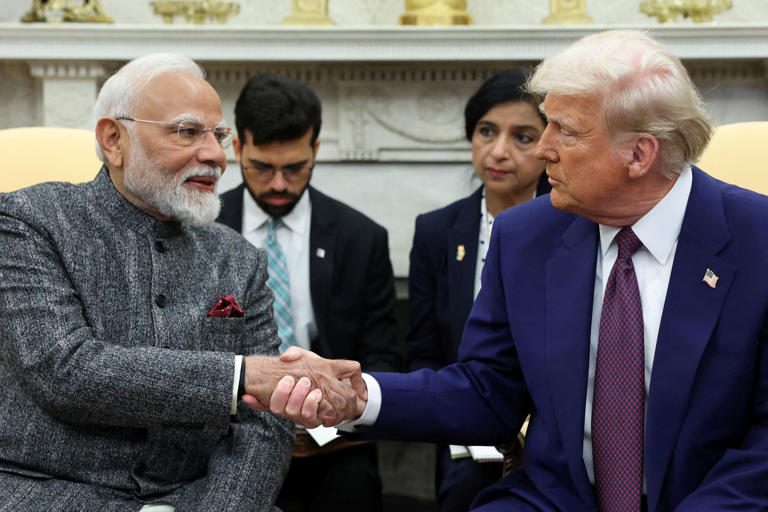Trade ties between India and the United States are under new strain. President Donald Trump has announced a steep tariff hike on Indian goods, raising the total duty to 50% by adding another 25% on top of what’s already in place. This step is a reaction to India’s ongoing purchase of Russian oil. The new tariffs are set to start on August 27, 2025.
Why This Matters
The United States is India’s largest export market, accounting for 18.03% of India’s outbound shipments in 2024. According to trade data, key exports from India to the U.S. include:
- Electrical and electronic equipment – 15.52% of total U.S.-bound exports
- Pearls, precious stones, metals, and coins – 11.51%
- Pharmaceutical products – 10.97%
- Machinery and nuclear reactors – 6.89%
- Mineral fuels and distillation products – 5.51%
Any disruption in this trade route could affect billions of dollars in revenue and put jobs at risk in manufacturing, IT, and agriculture.
India’s Possible Response
With only 20 days to respond, India is showing it wants to negotiate rather than retaliate. Some of the proposals being considered include:
- Allowing imports of genetically modified corn for industrial use only, with strict traceability protocols.
- Selective agricultural and dairy concessions, designed to appease U.S. concerns while shielding Indian farmers from competitive pressure.
Policymakers hope these specific concessions will ease tensions while still protecting India from a surge of imports.
The Exporters’ Rush
Indian exporters are rushing to send goods to the U.S. before the August 27 deadline. Industries such as textiles, gems, and electronics are seeing a spike in shipments.
Strategic Shifts Ahead
Beyond immediate talks, India is also working on:
- Export diversification – reducing over-reliance on the U.S.
- Trade reforms – to make Indian products more competitive globally.
- Contingency plans – to safeguard jobs if negotiations fail.
The Road Ahead
Trump’s ultimatum puts India under pressure, and the next three weeks may shape the future of trade between the two countries. If they find common ground, a tariff war could be avoided. If not, Indian exporters will face a tougher U.S. market and may need to seek new opportunities.
Trump’s Trade Ultimatum: India Has 20 Days to Respond
Trade ties between India and the United States are under new strain. President Donald Trump has announced a steep tariff hike on Indian goods, raising the total duty to 50% by adding another 25% on top of what’s already in place. This step is a reaction to India’s ongoing purchase of Russian oil. The new tariffs are set to start on August 27, 2025.
Why This Matters
The United States is India’s largest export market, accounting for 18.03% of India’s outbound shipments in 2024. According to trade data, key exports from India to the U.S. include:
- Electrical and electronic equipment – 15.52% of total U.S.-bound exports
- Pearls, precious stones, metals, and coins – 11.51%
- Pharmaceutical products – 10.97%
- Machinery and nuclear reactors – 6.89%
- Mineral fuels and distillation products – 5.51%
Any disruption in this trade route could affect billions of dollars in revenue and put jobs at risk in manufacturing, IT, and agriculture.
India’s Possible Response
With only 20 days to respond, India is showing it wants to negotiate rather than retaliate. Some of the proposals being considered include:
- Allowing imports of genetically modified corn for industrial use only, with strict traceability protocols.
- Selective agricultural and dairy concessions, designed to appease U.S. concerns while shielding Indian farmers from competitive pressure.
Policymakers hope these specific concessions will ease tensions while still protecting India from a surge of imports.
The Exporters’ Rush
Indian exporters are rushing to send goods to the U.S. before the August 27 deadline. Industries such as textiles, gems, and electronics are seeing a spike in shipments.
Strategic Shifts Ahead
Beyond immediate talks, India is also working on:
- Export diversification – reducing over-reliance on the U.S.
- Trade reforms – to make Indian products more competitive globally.
- Contingency plans – to safeguard jobs if negotiations fail.
The Road Ahead
Trump’s ultimatum puts India under pressure, and the next three weeks may shape the future of trade between the two countries. If they find common ground, a tariff war could be avoided. If not, Indian exporters will face a tougher U.S. market and may need to seek new opportunities.





 Easy & quick
Easy & quick
Leave A Comment?